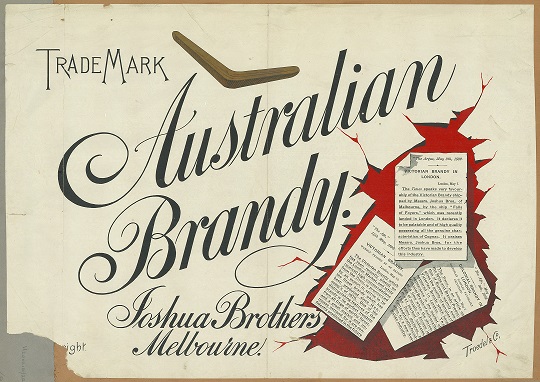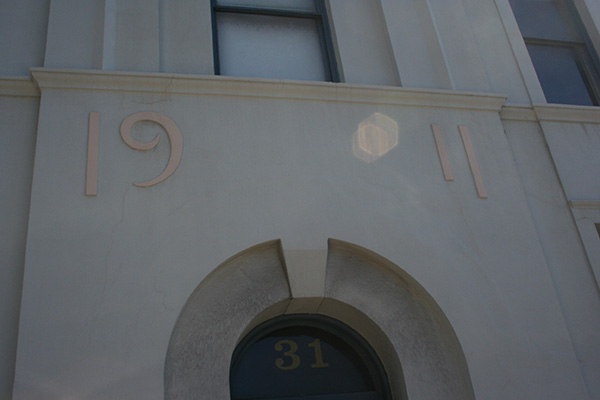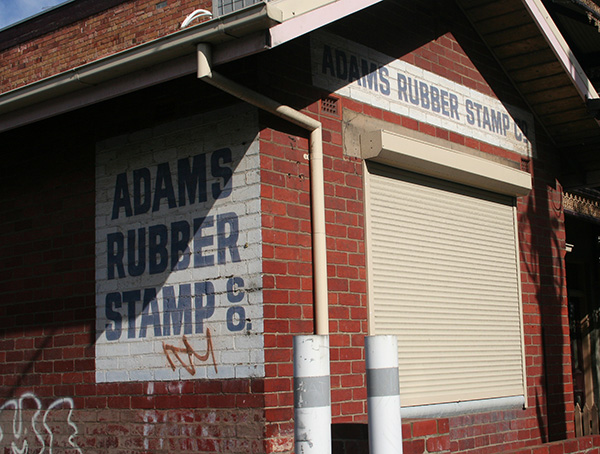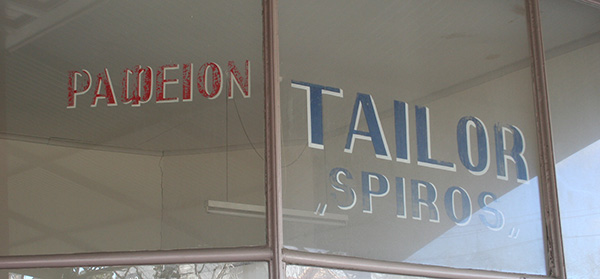Leaving Gasworks Arts Park, we headed south down Pickles Street into Port Melbourne. Like South Melbourne – the suburb formerly known as Emerald Hill – Port Melbourne once had a different name, and in the 19th century was known as Sandridge. There used to be a lagoon here too, though it has long been filled in. But there’s plenty of evidence of other transformations in this once working class, now gentrified neighbourhood.
On the Pickles Street wall of the Gasworks Arts Park is a quirky mural, which by the look of it could be 20 or 30 years old. I don’t know who painted it, or when, and its purpose is obscure. It doesn’t have any obvious meaning, unlike the anti-uranium mural I wrote about here, so we are free to interpret it as we wish. Pyramids, dominoes, beer glasses and even the Queen are jumbled together in a surreal cocktail.

Mural on Pickles Street

The main activity of Port Melbourne, obviously, was the port, and the area was heavily dependent on shipping; but there also used to be substantial industrial activity. A 1903 Australian handbook listed the following industrial sites in Port Melbourne: “an extensive biscuit factory (Swallow and Ariell’s), Poolman’s sugar refinery, Kitchen’s soap and candle works, Cuming, Smith and Co’s chemical works; Harper’s rice and flour mills, also gasworks, Joshua’s distillery, boot factory”.
One very obvious clue is provided by the ghostsigns on the Pickles Street wall of what was once the Joshua Brothers distillery, and is now apartments. The buildings date from the 1890s, but the beautiful, detailed signs were added in the 1960s, when United Distillers occupied the site and used its walls as a gigantic billboard. A series of superbly painted bottles are displayed along the wall, turning it into a giant bar. These were not Joshua’s products of course, but brands controlled by the later company. There may have been a bit of restoration, but the character of the signs is unchanged and it’s good to see that in this case the developer had the sense to retain these fading ads, which add to the building’s story. Windows and staircases now open out of some of the bottles, as if residents are looking out from inside a gin or whisky bottle.
You can no longer get pickled on Pickles Street, but you can get a sense of what the distillery used to be like in the days of Joshua Brothers from these images:

Joshua Brothers distillery in 1894. Source: State Library of Victoria.

Joshua Brothers distillery in 1913. Source: State Library of Victoria

Joshua Bros advertisement. Source: State Library of Victoria.
From Pickles Street, as we approached the water, we turned right into Rouse Street. This too was an important manufacturing area, as is shown by its entry in the 1903 edition of Sands & McDougall’s directory. Besides several factories, the street also contained a confectioner, a tailor, a couple of hotels, and a shoeing forge for what would these days be called ‘equine footwear solutions’. You can imagine horses between the shafts of drays plying these streets, pulling biscuits, sugar, and barrels of grog from Joshua’s; I dare say a few fell off the back from time to time.

Sands & McDougall directory, 1903.
Harper’s Starch factory, like the distillery, is now apartments, named Sandridge Bay Towers, in which the old name of the suburb is revived. Though I don’t like everything about the conversion it’s more attractive than most of the more recent buildings around here. Built in the 1890s it has that solid Victorian confidence about it. Robert Harper was a leading Melbourne businessman of his day, another one of those self-important anti-fun Presbyterian capitalists who set the tone of Melbourne’s commercial, political and religious life in the late 19th century.
A highlight of the factory is the chimney, which ranks alongside the Clifton Hill shot tower in the Melbourne pantheon of Victorian bricklaying. I like the fact that the Victorians considered something as functional as a chimney worthy of adornment in the form of those polychromatic rings. And I marvel at the level of skill and courage required by the bricklayers. It’s like a vertical work of art.

Before it was pimped up to its current state, the Harpers factory was used in 1979 as the location for the Halls of Justice in the original Mad Max movie (I am indebted to David Thompson for this fascinating factoid – read his story here).
A little further along Rouse street we came to the complex of buildings owned by the well known firm of Swallow and Ariell Ltd, whose former ‘Steam Biscuit Manufactory’ is now, you guessed it, apartments. The company started out making ship’s biscuits in the 1850s, before expanding into preserved fruits, jams, cakes and more. It is said that Burke and Wills took Swallow and Ariell biscuits on their disastrous expedition, though clearly not enough of them. Swallow & Ariell was a household name, the fifth largest biscuit company in the world (says eMelbourne), manufacturing over 100 varieties – anyone remember Sheik creams, Tango creams, and Town Hall creams? Anyway, the company made a massive contribution to the Australian love of bikkies.

A consignment of biscuits outside the Swallow & Ariell factory in 1917. A gift from the Australian Red Cross to prisoners of war in Europe. Source: Australian War Memorial.

The original art for a Swallow & Ariell advertisement of the 1920s. Source: State Library of Victoria.
The factory continued operation until 1991, when the last 450 workers lost their jobs – part of the decimation of manufacturing that took place around that time. The aroma of baking had been ever-present in the streets of Port Melbourne for well over a century.
The bird has flown, but this building remains one of the most elegant of the surviving Victorian factories in Melbourne. Today, young professionals are stacked between those walls like bikkies in a tin. The National Trust of Australia (Victoria) has more information about the site here. They also point to a lovely film from 1932, ‘A Day in a Biscuit Factory’, which is well worth a look.




Details of the Swallow and Ariell complex.
One of my favourite Port Melbourne buildings, though, is not in such pristine condition. We came across this cottage, ‘Chuley’, on Foote Street. Chuley is making its own last stand against the rising tide of gentrification, with its sagging timbers, unpainted facade, bathtub and tyres ornamenting the front yard. Undoubtedly, ‘Chuley’ has a few stories to tell.


Chuley: a one-house protest against gentrification.
There are many more ghostsigns around Port Melbourne, some plain and others ornate, each pointing to a part of the suburb’s history.




Another mural: though there’s not a lot of street art around here, this impressive pair of jaws grins at passing cars on Graham Street. Wonder if he likes biscuits.

One of the most characteristic features of Port Melbourne, though, is its bluestone laneways. Bluestone: practical, tough, non-fancy stuff, it was used by the ton for roads and walls and drains and houses around the inner suburbs in the late 19th century, and bluestone-grey is one of the most typical colours of Melbourne. Though this suburb has changed drastically, the alleys look much the same as they always have, and you can imagine all kinds of stories played out in them. In a sense bluestone is the stuff that holds Port Melbourne and neighbouring suburbs together: everyone has walked on it, from the night-cart men of the past to the young professionals of today; sailors and wharfies, crims and coppers, drunks and temperance advocates, factory workers and bosses, Robert Harper and Spiros the tailor. Though they may look empty, walking down these plain, practical laneways you feel the presence of other lives.
*
Port Melbourne Historical and Preservation Society has a wealth of information about the suburb. In particular, check out this entertaining post about Port Melbourne on film.
This short video about industry in Port Melbourne includes historical pictures of Swallow & Ariell, Joshuas, Harpers, Holden and more.
For even more on Port Melbourne check out Janet Bolitho’s well-informed blog Port Places.





















Another fine post. My partner is a volunteer driver in the area and there are still quite a number of very old residents of the wharfie and factory generation.
Thanks Andrew.
Glad you made it to my hood…
Me too, it’s a fascinating hood!
The ‘surreal’ mural was painted by a group led by Bill Hay in the late 70’s. Bill is still an active painter. He applied to the local council to get permission to paint it but a couple of days before work was planned to begin council got cold feet and sent him a letter withdrawing permission. Bill somehow ‘forgot’ to open the envelope and the group went ahead and painted it anyway and thanks for that!
Great, thanks for solving that mystery!